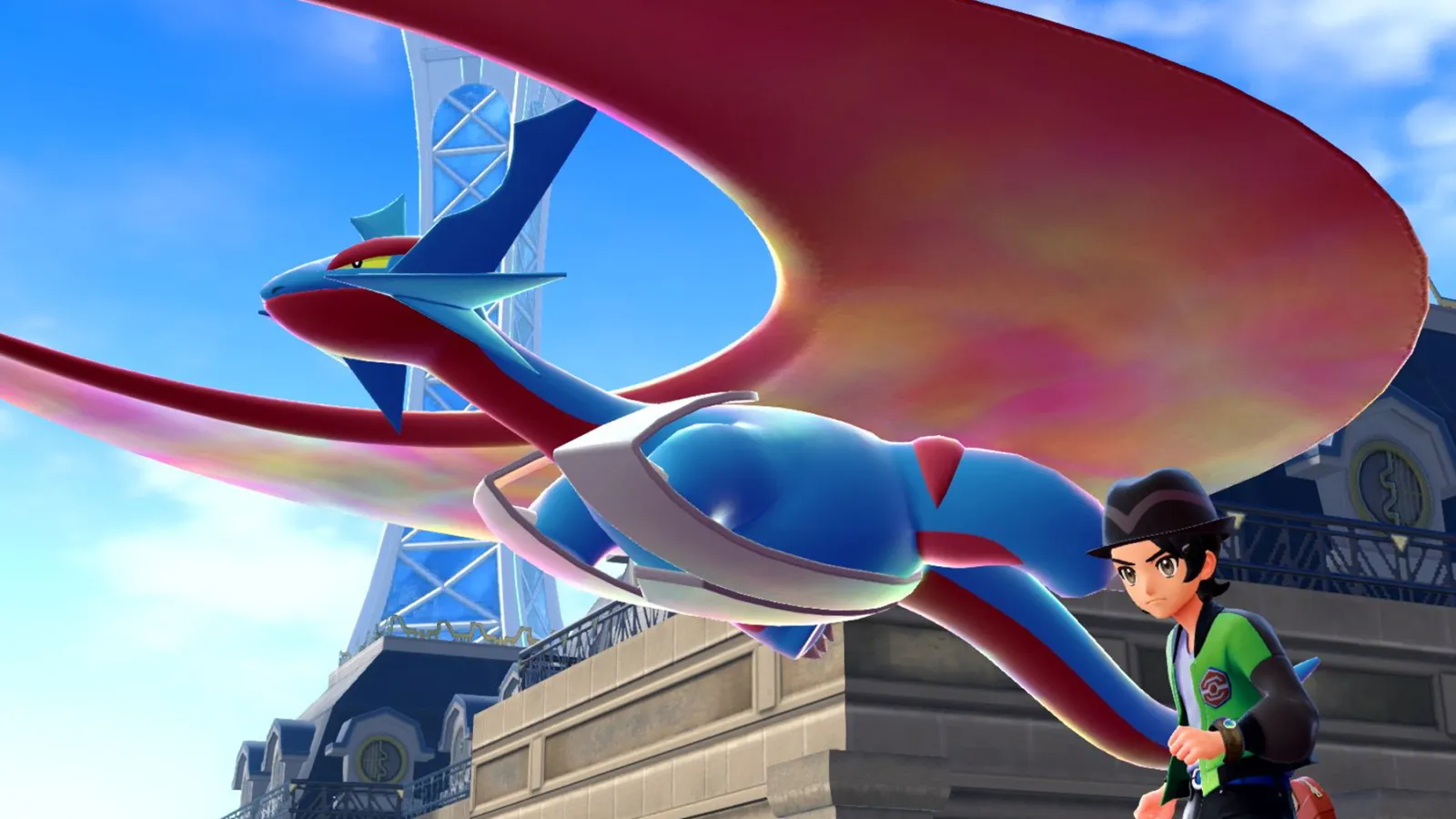
There’s something inherently ballsy about the fact that Nintendo has never really bothered to modernize Pokémon. After nearly 30 years and nine “generations” of mainline titles — not including an endless sea of spin-offs — the games have mostly been more of the same. They’re beginner-friendly RPGs predicated on collecting cute little pocket monsters and becoming the very best in a global network of officially sanctioned animal fighting rings.
Sure, there’s little iterations and evolutions to the base mechanics (sometimes you can fight with two Pokémon!) but despite being the highest-grossing media franchise of all time, most of the actual releases of the last two decades have felt somewhat half-hearted. Mostly sticking to turn-based combat in a world of action RPGs, the series often feels dated, even when there’s some new gimmick at play. Technologically, the latest entries feel generations behind what Nintendo should be capable of, especially when franchises like Zelda and Donkey Kong have morphed into visual and physics-based powerhouses.
This year’s new entry, Pokémon Legends: Z-A (out Oct. 16) doesn’t aim to tackle all those issues, but it does have its sight set on some. Smaller in scope than the standard continent-spanning Pokémon title, its story is set in just a single location: the Paris-coded city of Lumiose. But the real draw is the new combat system which moves away from the traditional turn-based cadence, instead letting battles play out in real time while the player runs around in the chaos.
Rolling Stone recently played a preview demo of Pokémon Legends: Z-A and found that its small steps forward could spell great things for the franchise ahead. Here’s how.
City living
The premise of Pokémon usually adheres to a strict rubric: players embody an aspiring trainer, pick one of three starter creatures, and begin the journey toward sports celebrity fame. Along the way, there’s usually some crime syndicate causing trouble and towns filled with folks looking for help, but the primary throughline is collecting, training, and battling.
Editor’s picks
That holds true for Z-A, but the initial stakes shown in the game’s opening moments feel decidedly smaller — or, more appropriately, local. Upon booting up the game and working through a pretty robust character creator, players arrive in Lumiose City and are immediately ambushed by a content creator/social media manager working for the corporation Quasartico, Inc. Lumiose is a European-esque metropolis with one key hook: here, humans and Pokémon live side-by-side in harmony. Sort of.
As the eager creator explains when trying to capture a testimonial video, Lumiose is attempting to bridge the social gap between people and monsters by building Wild Zones within the city where Pokémon can live naturally without being owned by a trainer. The town itself is also undergoing a massive urban re-development initiative led by Quasartico — which definitely reeks of gentrification and will probably be nefarious in the long run. But who’s to say how far down the rabbit hole of local politics the game is willing to go?
As a location, Lumiose is nicely sized, if a little quaint. It takes its Paris inspiration very literally, with buildings modeled after 19th-century French architecture and narrow streets peppered with outdoor cafes. At the center of town, there’s an Eiffel Tower-like structure that serves as a helpful landmark for getting your bearings. It’s charming and filled with points of interest across the in-game map, feeling less sparse than the typical Pokémon town.
Related Content
Familiar comforts with an action-heavy twist
The demo provided by Nintendo jumps around to show off the different aspects of gameplay that will make up the core experience. Players begin with the classic choice of which starter Pokémon they want between the grass-based Chikorita, water-type Totodile, or the fire-powered Tepig. Older players may recall the first two from the second gen games Gold and Silver (1999), while the latter returns from 2010’s Black and White.
After choosing an adorable life partner, the world opens for exploration. The moment-to-moment action is predicated on wandering the city, picking up little bits of information from people, and diving into Wild Zones to battle and capture more Pokémon. It’s here where the basic Pokémon experience returns to show off its new colors.
In most entries, players walk around areas outside of towns and run into Pokémon to battle. In older games, that meant randomly cutting to a combat screen when bumping into an invisible creature, but newer ones like 2022’s Scarlet and Violet let users see Pokémon out in the wild. Here, you can see one and immediately decide whether to engage or run. Choosing to engage means players can toss out one of their own Pokémon, all accessible at any time with quick button presses, or just skip the process and chuck a Poke ball at the back of the creature’s head.
The real-time battles see Pokémon automatically jumping into the fray, but it’s up to the player to quickly select the moves they’ll use. Rather than bouncing back and forth in the tête-à-tête of each creature’s turn, each attack has its own cooldown timer, so it’s important to keep an eye on both when moves are available and strike fast. Multiple Pokémon can enter the melee, too, so it’s unwise to go aggravating a whole pack of Skiddo or Buneary and being outnumbered.
One big addition here is that trainers themselves can be targeted by Pokémon, removing the barrier of safety usually afforded to players. Encounters require both navigating the space with the trainer to avoid getting knocked out and issuing commands to your own combatants to win the fight. Given the emphasis on an active playing field, things can quickly become hectic when trying to position yourself and the Pokémon properly, while also correctly timing the right attacks to capitalize.
Even at the lower levels, groups of Pokémon pose a solid threat, and the less passive controls add a level of urgency rarely found in the series. Multiple times, I found myself running in circles or sprinting away from a murder of airborne assailants to avoid being KO’d. There are also stronger alpha-type Pokémon that are much more dangerous. One encounter with a red-eyed Pikachu on the roof of a building quickly wiped out my whole crew; the only option being to leap off into the alleyway below. Later, from the safety of an adjacent patio, I could still see that Pikachu stalking his domain with bloodlust.
Gotta be the best
Outside of the freeform battle and capture, there’s the matter of professional competition within Lumiose City. Z-A has a full day and night cycle, with a ticking clock in the top left corner of the screen showing the passage of time. Each night, the city turns into a large-scale stadium as an alert rings out that a special Battle Zone has opened. By selecting the zone from the map, players can fast travel and enter the corralled section of Lumiose for the Z-A Royale.
This mode replaces the older games’ gyms, where players seek out other trainers and battle for points to promote their rank. Each instance of the royale lasts a full night and must be completed within the time frame to garner enough points to quality for a rank battle. Beating enough trainers and knocking out a couple of challenges should grant the required points to track down an in-world opponent of the same rank (going from Z to A) that must be defeated. These ranked trainers have a little more personality and backstory baked into than the standard fare roaming in the night, and toppling them is the path to progress.
There are also some major story related battles that come into play; the one featured in the demo focused on rogue Mega-Evolved Pokémon wreaking havoc on the city (and lowering the property values!). Skipping through all the context, we were able to jump into the battle with a Rogue Mega Victreebel to see what this new layer adds.
The encounter plays out more like a boss fight than a standard skirmish, with both the player-controlled character and a CPU-managed backup trainer running around the enclosed area to fight the single-story height beast. Dodging its attacks against the trainers is paramount, as is collecting aura that can power up your own Pokémon to do their own temporary Mega Evolutions. The process is slightly more of a battle of attrition than the usual engagements, adding an intense change of pace even beyond the action-heavy additions to basic combat.
Catching up with the times
Given its global dominance and cultural ubiquity over the last three decades, the Pokémon franchise doesn’t necessarily need to evolve to remain relevant. Nintendo could continue re-issuing older games and making incremental updates for another 10 years and these games would still sell ridiculously well. And, to be fair, even with a more neatly curated setting and overhauled combat systems, there’s still plenty that’s lacking in Z-A.
The demo version was running on a Switch 2 console, but the benefits of the devices improved horsepower weren’t readily apparent. The game ran smoothly — much better than previous entries on the first Switch, whose titles like 2019’s Sword and Shield and this Z-A’s prequel Arceus both suffered from low frame rates and resolution. It’s unclear how this new release will run on older Switch hardware (it’s launching on both), but even on the latest model, the game looks just fine.
One would think that by narrowing the scope of its world to a single city, a more on-rails approach would boost the game’s fidelity. But alas, developers Game Freak have opted to improve the aesthetics just enough to skirt online bellyaching rather than making any attempt to wow fans. It’s hard not to wonder what a contemporary Pokémon game could look like if its creators were willing to leave the aging Switch models behind and commit to a less technically comprised vision.
To be fair, Pokémon Legends: Z-A is still considered something of spin-off, serving as the second part of the Legends sub-series. It’s possible that all Z-A’s new ideas and systems are being tested here before being introduced to the mainline Pokémon games properly.
Trending Stories
But for now, this is what we get — a self-contained experiment that certainly plays better, or at last less passively, than the Pokémon games of yore. If the full release can continue to generate oddly pulse-pounding moments like the near-death rooftop fight with an evil-eyed Pikachu, then Z-A might be worth an extended stay in Lumiose.
Pokemon Legends: Z-A launches on Oct. 16 for Nintendo Switch and Switch 2.



